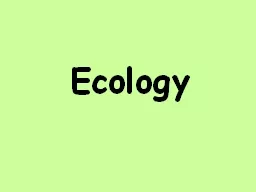

What is Ecology Ecology the study of relationships among living organisms and the interactions with their environments Ecologist a scientist who studies ecology Perform tests in organisms environments ID: 779039
Download The PPT/PDF document "Ecology Organisms & Their Relation..." is the property of its rightful owner. Permission is granted to download and print the materials on this web site for personal, non-commercial use only, and to display it on your personal computer provided you do not modify the materials and that you retain all copyright notices contained in the materials. By downloading content from our website, you accept the terms of this agreement.
Slide1
Ecology
Slide2Organisms & Their Relationships
Slide3What is Ecology?
Ecology =
the study of
relationships
among living organisms and the interactions with their environments. Ecologist = a scientist who studies ecology Perform tests in organisms’ environments
Slide4Biosphere
Biosphere =
the portion of the earth that supports
life.
Extends into the atmosphere and below the Earth’s surface into the deep ocean (deep ocean vent) Includes land masses, bodies of water, atmosphere, frozen polar regions, deserts, rainforests
Slide5Biosphere
Chlorophyll=
a green pigment found in green plants and algae.
Good indicator of the distribution of living things
Slide6Parts of the Environment
Biotic Factors =
All the
living
factors in an organism’s environment. Interactions among organisms are necessary for the health of all species in the same geographical area
Slide7Parts of the Environment
Abiotic Factors =
all the
nonliving
factors in an organism’s environment. Organisms that live in the same geographic area might share the same abiotic factors Examples of abiotic factors: Temperature, air or water currents, sunlight, soil type, rainfall, or available nutrients
Slide8Levels of Organization
Biosphere
Biome
Ecosystem
Community
Population
Organism
Slide9Populations
Population =
individual organisms of a
single species
that share the same geographical location. Dandelions in a fieldStudents at Apollo High School Can you think of any other examples of populations? Organisms within a population compete for resources.
Slide10Community
Community =
A group of
interacting populations
that occupy the same geographic area at the same time. Organisms within a community MAY OR MAY NOT compete for resources
Slide11Communities
Community =
A group of interacting
populations
that occupy the same area at the same time. Not all communities include the same variety of organisms
Slide12Communities
How do abiotic factors affect biological communities?
Organisms adapt to the conditions in which they live.
Slide13Ecosystem
Ecosystem=
a
community (living)
and all of the abiotic factors that affect it. Abiotic factors = water, soil, atmosphere, energy transfer
Slide14Biomes
Biome =
a large group of ecosystems that share the same
climate
and have similar types of communities. All of the biomes on earth combined form the biosphere
Slide15Habitat
Habitat =
An area where an organism lives
One tree (for an organism that spends its entire life in a tree)
Grove of trees (for an organism that moves from tree to tree) What types of resources do species find in their habitats?
Slide16Niche
Niche =
the role or position that an organism has in its environment
Requirements for food, shelter (temperature & moisture level) and reproduction conditions
Slide17Niche
Generalists
= species with
broad
niches (ex: possums and raccoons)Specialists = species with narrow niches (ex: koala)
Slide18Community Interactions
Slide19Competition
Competition
occurs when more than one organism uses a
resource
at the same time. Food, water, space, & light
Animals competing for water during a drought – The strong survive!!!
Competitive Exclusion
= one species is eliminated from a community due to competition.
Slide20Predation
Predation =
the act of one organism
consuming
another organism for food. Predator = the organism that pursues another organism Prey = the organism that is pursued
Lizardfish & Gobey
Slide21Predation
Predators evolve
adaptations
to
capture prey and prey evolve adaptations to escape/avoid predators.
Predator Adaptations
:
spider webs ; tiger stripes
Prey Adaptations
:
mimicry, plant toxins
Slide22Species Interactions
Symbiosis
: the close
relationship
that exists when two or more species live together.
Types of Symbiosis
:
Parasitism, Mutualism, Commensalism
Slide23Mutualism
Mutualism =
the relationship between two or more organisms that live closely together and benefit from each other.
Example:
Lichens = mutualism between fungi and algae Algae provide food for the fungi Fungi provide a habitat for the algae
Slide24Mutualism
Cleaner Fish & Ocean Sunfish
Ocean Sunfish & Gull
http://www.arkive.org/sunfish/mola-mola/video-11.html
Slide25Commensalism
Commensalism =
relationship in which one organism benefits and the other organism is not helped or harmed.
Clownfish & Sea Anenome
Clownfish benefits, sea anenome is not harmed
Slide26Commensalism
Barnacles
Slide27Mutualism and Commensalism
Are plants and pollinators engaged in a mutualistic or commensalistic relationship?
Slide28Parasitism
Parasitism =
relationship in which one organism benefits and one organism is harmed.
Ectoparasite
– external (ex: tick, lice)
Endoparasite
–
internal (ex: tapeworm, bacteria, roundworms)
Slide29Parasitism: Heart Worm
If host dies:
The parasite must quickly find another host or it will die as well.
Slide30Parasitism: Roundworm
Types of Parasitic Roundworm Diseases
Ascariasis
Hookworm Disease
Pinworm Infection
Strongyloidiasis
Trichinosis
Whipworm Disease
Slide31Tapeworm
The beef tapeworm can be up to 25 feet in length in the human intestine!!!
Slide32Tongue-Eating Louse
A crustacean that enters through the fish’s gills and then attaches to the fish’s tongue.
Later becomes the tongue & fees on blood or mucus from the fish.
Fish can still use the tongue!!!
Slide33Brood Parasitism
Brown-headed cowbirds demonstrate brood parasitism because they rely on other bird species to:
build their nests
incubate their eggs
Baby cowbirds push the host’s eggs or young from the nestLower population of songbirds